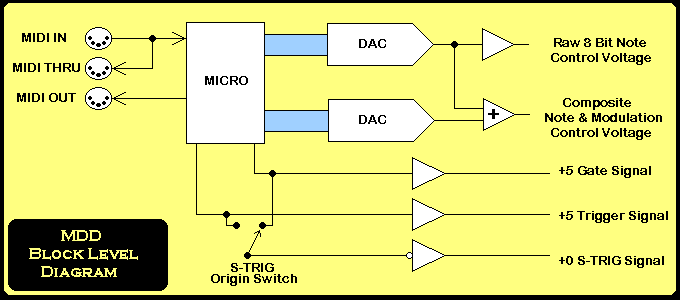
MIDI to Control Voltage Converter

MIDI Interface
-
MIDI IN
- Connects to the MIDI output of a Keyboard, Sequencer, or other controller device.
MIDI THRU- Repeats all incoming MIDI data electrically without change or latency.
MIDI OUT- emits incoming MIDI messages filtered so that NOTE ON/OFF Message Pairs convert to Running status (MIDI OFF = MIDI ON-Velocity 0).
- Repeats all incoming MIDI data electrically without change or latency.
-
Voltage Output 1
- Raw 7 Bit MIDI to Control Voltage Output. MIDI Note values translate to 1 volt per octave VCO frequency voltage source.
Voltage Output 2- Summed Composite of Raw Control Voltage, MIDI Pitch Bend, Integrated Noise, and Low Frequency Oscillator. Both outputs provide full 10 Octave control voltage Span.MIDI 00 = 0 Volts.
Control Interface- +5 Volt Positive going GATE and TRIGGER. S-TRIG (MOOG Trigger) is "selectable" to operate from GATE or TRIGGER. GATE asserts as long as any key is ON, TRIGGER asserts with any New Note On event.
Additional Features- Trigger Pulse responds to Note Velocity. Selectable responses are Velocity Width or Velocity Delay modes. Velocity Width causes the Trigger Pulse to narrow with increasing Velocity Values. Velocity Delay causes the Trigger Pulse to delay it's activation with decreasing Velocity values(referenced to the leading edge of the GATE signal). Dynamic Trigger modes provide functionality similar to voltage controlled Trigger functions.
- Summed Composite of Raw Control Voltage, MIDI Pitch Bend, Integrated Noise, and Low Frequency Oscillator. Both outputs provide full 10 Octave control voltage Span.MIDI 00 = 0 Volts.
-
The Low Frequency Oscillator
- allows triangular modulation at a user selected "depth" to provide vibrato.
Random Noise- provides random modulation of the control voltage.
The Control Voltage Output- can be "offset" (above and below zero) to accommodate a variety of VCO's.
Standard MIDI CC Messages- control over Pitch Bend, Modulation Depth, LFO Freq. and amplitude, Velocity Trigger Mode Select and Noise Amplitude.
- provides random modulation of the control voltage.
Parameter Entry
Standard MIDI CC Messages map to the various features of the interface allowing manual control of each "setting" or for programmatic setting by an attached Sequencer (or keyboard with "macro" capability).
Parameter controls include;
- 1) LFO Frequency
- 2) LFO Depth
- 3) Noise Depth
- 4) Trigger Type (Delay/Width) Select.
- 2) LFO Depth